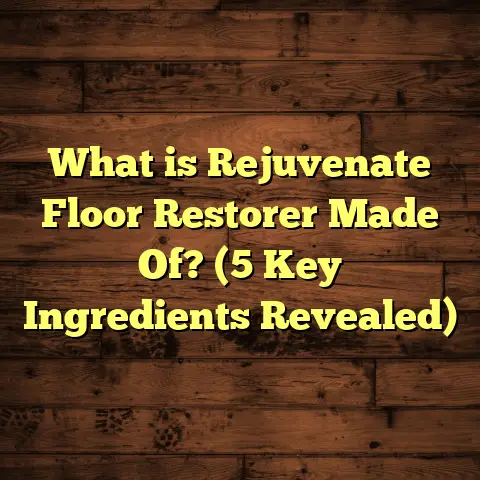What is a Screed Floor? (5 Key Benefits for Your Home)
When I think about homes, my mind instantly drifts to children—their endless energy, their curious hands exploring every corner, and their little feet pounding on floors as they play. As a flooring contractor who’s spent years helping families create safe and beautiful living spaces, I know that the floor is more than just a surface; it’s where memories are made. I’ve seen kids tumble, crawl, and sit comfortably on floors that offer warmth and stability. That’s why choosing the right kind of flooring foundation is so important—especially for homes with children. One solution I frequently recommend is a screed floor.
What Is a Screed Floor?
You might be wondering, what exactly is a screed floor? The term “screed” refers to a smooth, flat layer of material—typically a mixture of cement, sand, and water—that’s applied over a structural base like concrete or a subfloor. This layer is designed to create an even surface for the final flooring layer.
Think of it like the canvas for a painting. Before you add tiles, hardwood, or vinyl, you want your floor base to be perfectly flat and stable. The screed does exactly that. It fills in cracks, smooths out bumps, and levels the surface so your final flooring can be installed without issues.
From my experience, many homeowners overlook this critical step. But trust me—taking the time to lay down a properly mixed and leveled screed can prevent headaches later on.
Why Is Screed Important?
The structural floor beneath your home—usually concrete—rarely comes out perfectly flat after pouring and curing. Small dips or lumps can cause tile cracking or wooden boards to warp. Without a screed layer, you risk uneven flooring that feels uncomfortable and ages poorly.
In addition to smoothing surfaces, screeds help protect your floor from moisture penetration, which is especially important in damp climates or basements.
Types of Screed Floors
There are several types of screeds available depending on your project’s needs:
- Traditional Sand-Cement Screed: The most common; offers durability and strength.
- Anhydrite Screed (Calcium Sulfate): Self-leveling with faster drying times; often used with underfloor heating.
- Fast-Drying Screeds: Designed for quick turnaround times in renovations.
- Liquid or Self-Leveling Screeds: These flow into place and level themselves automatically.
Each type has pros and cons depending on factors like drying time, cost, and intended use.
How Does Screed Work?
When I explain screeds to clients, I often use the analogy of icing a cake. The structural floor is like the cake itself—solid but uneven. The screed is the smooth layer of icing that makes everything level and ready for decoration.
The process starts with mixing the screed components: cement, sand, and water—sometimes with additives for improved performance. The mixture should have the right consistency—not too wet or dry—to ensure proper spreading.
Once mixed, the screed is poured over the base and spread using tools like straight edges or trowels until it’s perfectly flat. Then it’s left to cure (dry) thoroughly before any further work can be done.
The curing process is critical because if the screed is still damp when you install flooring over it, you risk warping or damage later on.
My Experience Using Screed Floors
Early in my career, I worked on a renovation project where the existing concrete slab was riddled with cracks and uneven spots. The homeowners wanted beautiful hardwood floors throughout but were worried about durability.
I recommended applying a sand-cement screed about 50mm thick to level out the surface. We took care to mix the screed properly and allowed it three weeks to cure fully.
After installing the hardwood over the screed, the results were impressive—the floor looked flawless and has remained stable for over five years now.
One lesson I learned was how much patience curing requires. Rushing this stage can lead to problems later on, so I always advise clients upfront about timelines.
5 Key Benefits of Screed Floors for Your Home
1. Safety for Kids and Family
If you have children like I do, safety is always top of mind. A floor that’s uneven can cause trips and falls—something no parent wants. A screed floor creates a smooth, even surface that reduces these risks substantially.
I recall a family with toddlers who were constantly tripping on uneven tiles in their old home. After installing a new screeded floor topped with vinyl, those accidents stopped almost immediately.
Besides preventing trips, screeds help eliminate gaps where dirt or pests could hide—creating a cleaner environment that’s healthier for kids.
2. Improved Durability and Longevity
Floors take a beating—especially in homes with active kids and pets. A properly installed screed acts like armor beneath your flooring by distributing weight evenly and protecting against cracks or shifts in the base slab.
According to research from construction industry bodies, floors with appropriate screeding can extend the lifespan of tiles or wood flooring by up to 30%. That means fewer repair costs over time—a big win for families on tight budgets.
3. Enhanced Thermal Efficiency
Have you ever felt cold feet during winter? Many homeowners don’t realize that screeds work perfectly with underfloor heating systems by conducting heat evenly across the surface.
I recently worked on a project in northern climates where we paired a liquid screed with electric underfloor heating mats. The result? The family reported a 15% drop in heating bills while enjoying cozy floors all winter long.
4. Better Sound Insulation
Noise can be a big issue in multi-story homes or apartments. Footsteps echoing through floors can disturb sleep or concentration.
Screeds help buffer sound transmission between floors by adding mass and sealing gaps where noise travels.
On one job, we used an acoustic-enhanced screed mix that cut footstep noise by nearly 40%, making it much easier for the household’s baby to nap peacefully during the day.
5. Versatility in Design Choices
Because screeds create such smooth surfaces, they work well under basically any type of flooring: hardwood, carpet, tiles, laminate—you name it.
I had clients who wanted ceramic tiles in kitchen areas but hardwood in living spaces. Thanks to a well-leveled screeded base, transitioning between these materials was seamless without any unevenness or cracking issues.
Deeper Look: Screed Materials and Their Properties
Understanding what goes into your screed mix can help you choose wisely based on your home’s needs.
Sand-Cement Screed
The classic option involves mixing sharp sand with cement (usually in ratios like 4:1 sand to cement). This mixture provides good strength and durability but takes longer to dry (often up to 28 days).
It’s affordable and widely available but heavier than some alternatives.
Anhydrite Screed
Made from calcium sulfate binders instead of cement, this screed flows easier and self-levels better than traditional mixes.
Drying times are faster—often ready for flooring after just one week—and it’s lighter weight too.
However, anhydrite isn’t suitable for wet areas as it reacts poorly to moisture unless sealed properly.
Liquid Screeds
These are highly fluid mixtures designed to spread out evenly without much manual effort. Great for complicated layouts or when you need very flat surfaces quickly.
The downside? They often cost more upfront but save labor time during installation.
Additives
Depending on project requirements, additives like plasticizers (for flexibility), accelerators (to speed curing), or fibers (for added strength) may be included.
Installation Nuances: What I’ve Learned Over Time
Screeding isn’t just about mixing materials—it’s an art combined with science. From my experience:
- Preparation is key: Clean and prime the base before pouring screed.
- Mix consistency matters: Too wet and it’ll shrink/crack; too dry and it won’t level properly.
- Use proper tools: Long straight edges help achieve flatness; power floats create smooth finishes.
- Curing conditions affect performance: Avoid drafts or direct sunlight during drying.
- Control joints: In large areas, joints should be placed in screeds to prevent cracking from temperature changes or movement.
On one project where we ignored control joints, hairline cracks appeared after six months—an expensive lesson learned!
How Screed Installation Fits Into Your Flooring Project Timeline
When planning flooring work involving screeds:
- Assess existing floor: Identify unevenness or damage.
- Choose screed type: Based on budget, drying time needs, moisture levels.
- Prepare base: Clean thoroughly; apply primer if needed.
- Mix & pour: Use correct ratios; spread evenly.
- Cure & dry: Allow enough time before next step.
- Final flooring installation: Lay tile/wood/vinyl after confirming dryness.
- Post-install inspection: Check for cracks or defects early to fix promptly.
One homeowner I worked with was impatient to install hardwood only two days after screeding—the boards buckled within weeks due to trapped moisture. That reinforced how important curing patience really is.
Maintenance Tips for Screeded Floors
Once your floor is installed over a screeded base, maintenance depends mostly on your final flooring choice—but here are some general tips I share:
- Ensure good ventilation during early weeks after installation to keep moisture low.
- Avoid heavy impacts during curing as fresh screeds can be fragile.
- For tiled floors over screeds: reseal grout lines regularly to prevent water ingress.
- Monitor for signs of cracking which may indicate movement below.
- If you have underfloor heating beneath your screed: warm gradually after installation to avoid thermal shock.
Troubleshooting Common Issues With Screed Floors
Even with careful installation, some problems can arise:
- Cracking: Often due to shrinkage or lack of control joints.
- Delamination: Where screed separates from base due to poor adhesion.
- Uneven surfaces: Caused by incorrect leveling during installation.
- Moisture problems: If subfloor moisture isn’t controlled before pouring.
When these occur, early diagnosis is key. I’ve helped clients repair minor cracks by injecting epoxy resins or grinding rough spots back level before reapplying final flooring.
Cost Factors: How FloorTally Helps Me Manage Estimates
Budgeting is always a tricky part of any flooring project. I use FloorTally regularly because it lets me plug in specifics like:
- Area size
- Screed type (traditional vs liquid vs anhydrite)
- Local labor rates
- Waste allowance (usually around 5%-10%)
This tool helps me provide clients with clear cost breakdowns so they know what to expect without surprises.
For example: On one job covering 1,500 sq ft with traditional sand-cement screed plus labor costs factored in, FloorTally gave an estimate within 5% accuracy compared to actual expenses—a huge help in planning.
More Case Studies From My Work
The Martinez Family Basement Remodel
They wanted a cozy playroom for their kids in their damp basement but had concerns about moisture damaging floors.
We applied anhydrite screed combined with waterproof membranes underneath before putting down engineered wood flooring.
Six months later, no signs of mold or warping appeared despite seasonal humidity swings—a success story showing how proper screeding protects vulnerable spaces.
Urban Apartment Renovation
In an older apartment building with noisy neighbors below, we installed an acoustic-enhanced liquid screed topped with cork flooring.
The residents reported significantly reduced footstep noise allowing better sleep for their young children—a big quality-of-life improvement thanks to thoughtful floor layering.
How Screeds Compare With Other Floor Leveling Methods
Some people ask me if self-leveling compounds or plywood leveling systems could replace screeds.
While these alternatives have their places:
- Self-leveling compounds often aren’t as strong structurally.
- Plywood leveling adds height which may conflict with door clearances.
Screeds remain the gold standard for durable flat floors that support heavy finishes like tile or hardwood over large areas.
Environmental Impact Considerations
In recent years I’ve noticed growing interest from clients about eco-friendliness.
Traditional cement-based screeds have a carbon footprint due to cement production emissions.
To address this:
- Some manufacturers now offer low-carbon cement options.
- Recycled aggregates can be used in mixes.
- Alternative binders like geopolymer cements are emerging technologies though not yet mainstream for residential use.
If sustainability matters to you, ask your contractor about green options when planning your floor.
Final Thoughts About Screed Floors
Looking back at all the projects I’ve worked on over the years—from family homes filled with laughter to quiet apartments—I’ve realized how foundational good flooring really is.
A well-installed screed floor quietly supports every step we take without asking for attention—but when it’s missing or done poorly, problems quickly surface that affect safety, comfort, and costs.
If you have kids running around your house as I do—or simply want peace of mind that your floors will last—consider adding a screed layer as part of your flooring project plan.
And if you want help estimating costs or choosing materials tailored to your home’s needs, just reach out—I’m happy to share what I’ve learned from hundreds of jobs so your floors can stand strong through all life’s moments.





